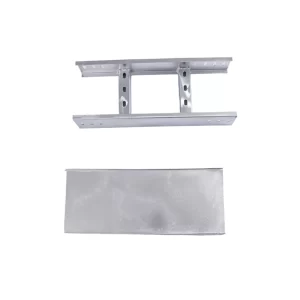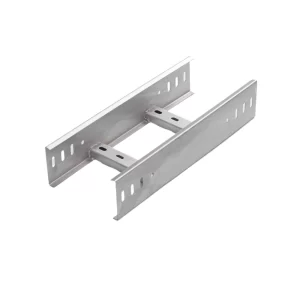In the world of electrical installations and cable management, aluminum cable trays play a significant role. These trays are designed to provide a reliable and efficient way to route and support electrical cables. With their unique properties and advantages, aluminum cable trays are widely used in various industries and applications. In this article, we will explore what aluminum cable trays are and their many uses.
Cable management is essential in any electrical installation to ensure the safe and efficient operation of electrical systems. Aluminum cable trays offer a practical solution for organizing and protecting cables, while also providing easy access for maintenance and troubleshooting. These trays are made of aluminum, a lightweight yet strong metal that offers several benefits over other materials.
What is an Aluminum Cable Tray?
An aluminum cable tray is a type of cable management system that consists of a series of channels or trays made of aluminum. The trays are designed to hold and support electrical cables, allowing them to be routed and organized in a neat and orderly manner. Aluminum cable trays come in various sizes and configurations to accommodate different cable sizes and quantities.
The aluminum used in cable trays is typically alloyed with other elements to enhance its strength, durability, and corrosion resistance. Some common aluminum alloys used for cable trays include 6061 and 6063, which offer a good balance of strength and corrosion resistance.
Features and Advantages of Aluminum Cable Trays
1. Lightweight
One of the main advantages of aluminum cable trays is their lightweight nature. Aluminum is much lighter than steel or other metals commonly used for cable trays, making it easier to handle and install. This can save time and labor costs during installation, especially in large-scale projects.
2. Corrosion Resistance
Aluminum has excellent corrosion resistance, which makes it suitable for use in a wide range of environments. Whether in indoor or outdoor settings, aluminum cable trays can withstand exposure to moisture, chemicals, and other corrosive elements without deteriorating. This ensures the longevity and reliability of the cable management system.
3. Conductivity
Aluminum is a good conductor of electricity, which can be beneficial in some applications. In certain situations, aluminum cable trays can help dissipate heat generated by electrical cables, reducing the risk of overheating and potential fire hazards. Additionally, the conductivity of aluminum can help reduce electromagnetic interference (EMI) and radio frequency interference (RFI).
4. Durability
Aluminum cable trays are highly durable and can withstand heavy loads and mechanical stress. They are designed to support the weight of electrical cables and can endure the rigors of daily use in industrial and commercial settings. The durability of aluminum cable trays ensures a long service life and reduces the need for frequent replacements.
5. Aesthetic Appeal
Aluminum cable trays have a sleek and modern appearance that can enhance the aesthetic appeal of an installation. They can be finished in different colors or textures to match the surrounding decor, making them a popular choice for architectural and interior design applications.
Applications of Aluminum Cable Trays
1. Industrial Settings
Aluminum cable trays are widely used in industrial environments such as factories, warehouses, and manufacturing plants. They are ideal for routing cables for machinery, control panels, and other electrical equipment. The lightweight and corrosion-resistant properties of aluminum make it suitable for use in harsh industrial settings where exposure to chemicals, moisture, and mechanical stress is common.
2. Commercial Buildings
In commercial buildings such as offices, hospitals, and shopping malls, aluminum cable trays are used to manage the cables for lighting, power outlets, and communication systems. The aesthetic appeal of aluminum cable trays makes them a popular choice for visible installations, where they can be integrated into the building’s design. Additionally, the durability and ease of installation of aluminum cable trays make them suitable for high-traffic areas.
3. Data Centers
Data centers require a reliable and efficient cable management system to support the large number of cables needed for servers, switches, and other networking equipment. Aluminum cable trays are often used in data centers due to their lightweight, corrosion-resistant, and conductive properties. The ability to dissipate heat and reduce EMI/RFI makes aluminum cable trays an ideal choice for data center applications.
4. Outdoor Installations
Aluminum cable trays can be used in outdoor applications such as power distribution lines, telecommunications networks, and street lighting. The corrosion-resistant nature of aluminum makes it suitable for exposure to the elements, while the lightweight design makes it easier to install and maintain in outdoor locations.
5. Renewable Energy Installations
In renewable energy projects such as solar farms and wind turbines, aluminum cable trays are used to route cables from the energy generation sources to the electrical grid. The lightweight and durable properties of aluminum make it suitable for use in these applications, where the cable trays may be exposed to harsh environmental conditions.
Installation and Maintenance of Aluminum Cable Trays
1. Installation
Aluminum cable trays are relatively easy to install. They can be mounted on walls, ceilings, or under raised floors using brackets, hangers, or clips. The trays can be joined together using connectors or couplers to create longer runs. During installation, it is important to ensure that the trays are level and properly supported to prevent sagging or deformation.
2. Maintenance
Regular maintenance of aluminum cable trays is essential to ensure their proper functioning and longevity. This includes inspecting the trays for signs of damage, such as bent or broken sections. Cables should be checked for wear and tear, and any damaged cables should be replaced promptly. The trays should be cleaned periodically to remove dust and debris, which can affect the performance of the cable management system.
Aluminum cable trays are a versatile and practical solution for cable management in various industries and applications. Their lightweight, corrosion-resistant, conductive, and durable properties make them an ideal choice for many installations. Whether in industrial settings, commercial buildings, data centers, outdoor installations, or renewable energy projects, aluminum cable trays provide a reliable and efficient way to route and support electrical cables. By understanding the features and uses of aluminum cable trays, you can make an informed decision when choosing a cable management system for your specific needs.



